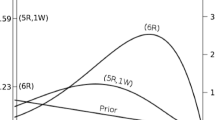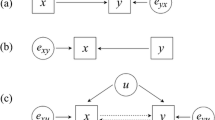Abstract
In behavior analysis, visual inspection of graphic information is the standard by which data are evaluated. Efforts to supplement visual inspection using inferential statistical procedures to assess intervention effects (e.g., analysis of variance or time-series analysis) have met with opposition. However, when serial dependence is present in the data, the use of visual inspection by itself may prove to be problematic. Previously published reports demonstrate that autocorrelated data influence trained observers’ ability to identify level treatment effects and trends that occur in the intervention phase of experiments. In this report, four recent studies are presented in which autoregressive equations were used to produce point-to-point functions to simulate experimental data. In each study, various parameters were manipulated to assess trained observers’ responses to changes in point-to-point functions from the baseline condition to intervention. Level shifts over baseline behavior (treatment effect), as well as no change from baseline (no treatment effect or trend), were most readily identified by observers, but trends were rarely recognized. Furthermore, other factors previously thought to augment and improve observers’ responses had no impact. Results are discussed in terms of the use of visual inspection and the training of behavior analysts.
Similar content being viewed by others
References
Austin, J., & Mawhinney, T. (1996, May). Relations among data analysts’ discriminations between baseline and intervention streams, methods of data presentation, and analyses. Paper presented at the 22nd annual convention of the Association for Behavior Analysis, San Francisco.
Baer, D. M. (1977). Perhaps it would be better not to know everything. Journal of Applied Behavior Analysis, 10, 167–172.
Bailey, D. B. (1984). Effects of lines of progress and semilogarithmic charts on ratings of charted data. Journal of Applied Behavior Analysis, 17, 359–365.
Bakan, D. (1954). A generalization of Sidman’s results on group and individual functions, and a criterion. Psychological Bulletin, 51, 63–64.
Busk, P. L., & Marascuilo, L. A. (1988). Autocorrelation in single-subject research: A counterargument to the myth of no autocorrelation. Behavioral Assessment, 10, 229–242.
Cleveland, W. S., & McGill, R. (1984). Graphical perception: Theory, experimentation, and application to the development of graphical methods. Journal of the American Statistical Association, 79, 531–554.
Cleveland, W. S., & McGill, R. (1985). Graphical perception and graphical methods for analyzing scientific data. Science, 229, 828–833.
Cleveland, W. S., & McGill, R. (1987). Graphical perception: The visual decoding of quantitative information on graphical displays of data. Journal of the Royal Statistical Society, A, 150, 192–229.
Cohen, J. (1988). Statistical power analysis for the behavioral sciences. Hillsdale, NJ: Erlbaum.
Crosbie, J. (1987). The inability of the binomial test to control Type I erro with single-subject data. Behavioral Assessment, 9, 141–150.
Crosbie, J. (1989). The inappropriateness of the C statistic for assessing stability or treatment effects with single-subject data. Behavioral Assessment, 11, 315–325.
Crosbie, J. (1993). Interrupted time-series analysis with brief single-subject data. Journal of Consulting and Clinical Psychology, 61, 966–974.
Deming, W. E. (1953). On the distinction between enumerative and analytic surveys. Journal of the American Statistics Association, 48, 244–255.
DeProspero, A., & Cohen, S. (1979). Inconsistent visual analyses of intrasubject data. Journal of Applied Behavior Analysis, 12, 573–579.
Ericsson, A. K., & Simon, H. A. (1980). Verbal reports as data. Psychological Review, 87, 215–281.
Estes, W. K. (1956). The problem of inference from curves based on group data. Psychological Bulletin, 53, 134–140.
Fisch, G. S., & Porto, A. F. (1994). Visual inspection of data: Does the eyeball fit the trend? In B. E. Rogowitz & J. P. Allebach (Eds.), Human vision, visual processing, and digital display V (pp. 268–276). Bellingham, WA: SPIE Volume 2179.
Fisch, G. S., & Schneider, R. (1993). Visual inspection of data: Placement of point-to-point graphs affects discrimination of trends and treatment effects. American Statistical Association Proceedings: Section on Statistical Graphics, 55–58.
Furlong, M. J., & Wampold, B. E. (1982). Intervention effects and relative variation as dimensions in experts’ use of visual inference. Journal of Applied Behavior Analysis, 15, 415–421.
Gentile, J. R., Roden, A. H., & Klein, R. D. (1972). An analysis-of-variance model for the intrasubject replication design. Journal of Applied Behavior Analysis, 5, 193–198.
Glass, G. V., Willson, V. L., & Gottman, J. M. (1975). Design and analysis of time series experiments. Boulder, CO: Colorado Associated University Press.
Greenspan, P., & Fisch, G. S. (1992). Visual inspection of data: A statistical analysis of behavior. American Statistical Association Proceedings: Section on Statistical Graphics, 79–82.
Greenwood, K. M., & Matyas, T. A. (1990). Problems with the application of interrupted time series analysis for brief single-subject data. Behavioral Assessment, 12, 355–370.
Grote, I., & Baer, D. M. (1996, May). Visual analysis of graphic data by scientists-in-training. Paper presented at the 22nd annual convention of the Association for Behavior Analysis, San Francisco.
Haccou, P., & Meelis, E. (1992). Statistical analysis of behavioural data: An approach based on time-structured models. Oxford, England: Oxford University Press.
Hahn, G. J., & Meeker, W. Q. (1991). Statistical intervals: A guide for practitioners. New York: Wiley.
Harrop, J. W., & Velicer, W E (1985). A comparison of alternative approaches to the analysis of interrupted times-series. Multivariate Behavioral Research, 20, 27–44.
Hartmann, D. P. (1977). Considerations in the choice of interobserver reliability estimates. Journal of Applied Behavior Analysis, 10, 103–116.
Hartmann, D. P., Gottmann, J. M., Jones, R. R., Gardner, W., Kazdin, A. E., & Vaught, R. S. (1980). Interrupted time-series analysis and its application to behavioral data. Journal of Applied Behavior Analysis, 13, 543–559.
Huitema, B. E. (1985). Autocorrelation in applied behavior analysis: A myth. Behavioral Assessment, 109–120.
Huitema, B. E. (1986). Autocorrelation in behavioral research: Wherefore art thou? In A. Poling & R. W. Fuqua (Eds.), Research methods in applied behavior analysis: Issues and advances (pp. 187–208). New York: Plenum Press.
Jones, R. R., Vaught, R. S., & Weinrott, M. (1977). Time-series analysis in operant research. Journal of Applied Behavior Analysis, 10, 151–166.
Jones, R. R., Weinrott, M., & Vaught, R. S. (1978). Effects of serial dependency on the agreement between visual and statistical inference. Journal of Applied Behavior Analysis, 11, 277–283.
Karp, H. J., & Fisch, G. S. (1996, May). Signal detection analysis of responses to graphic data produced by auto-correlation and least squares regression equations. Paper presented at the 22nd annual convention of the Association for Behavior Analysis, San Francisco.
Kazdin, A. E. (1977). Artifact, bias, and complexity of assessment: The ABCs of reliability. Journal of Applied Behavior Analysis, 10, 141–150.
Kazdin, A. E. (1978). Statistical analysis for single-case experimental designs. In M. Hersen & D. H. Barlow (Eds.), Single case experimental designs: Strategies for studying behavioral change (pp. 265–316). New York: Pergamon Press.
Kelly, M. B. (1977). A review of the observational data-collection and reliability procedures reported in the Journal of Applied Behavior Analysis. Journal of Applied Behavior Analysis, 10, 97–101.
Keselman, H. J., & Leventhal, L. (1974). Concerning the statistical procedures enumerated by Gentile et al.: Another perspective. Journal of Applied Behavior Analysis, 7, 643–645.
Kratochwill, T., Alden, K., Demuth, D., Dawson, D., Panicucci, C., Arntson, P., McMurray, N., Hempstead, J., & Levin, J. (1974). A further consideration in the application of an analysis-of-variance model for the intrasubject replication design. Journal of Applied Behavior Analysis, 7, 629–633.
Kratochwill, T. R., & Wetzel, R. J. (1977). Observer agreement, credibility, and judgment: Some considerations in presenting observer agreement data. Journal of Applied Behavior Analysis, 10, 133–139.
Lewandowsky, S., & Spence, I. (1989). Discriminating strata in scatterplots. Journal of the American Statistical Association, 84, 682–688.
Magnusson, D., Bergman, L. R., Rudinger, G., & Törestad, B. (1991). Problems and methods in longitudinal research: Stability and change. Cambridge, England: Cambridge University Press.
Matyas, T. A., & Greenwood, K. M. (1990). Visual analysis of single-case time series: Effects of variability, serial dependence, and magnitude of intervention effects. Journal of Applied Behavior Analysis, 23, 341–351.
Matyas, T. A., & Greenwood, K. M. (1991). Problems in the estimation of autocorrelation in brief time series and some implications for behavioral data. Behavioral Assessment, 13, 137–157.
McEwan, J. S. A. (1994). Optimising line graph aspect ratio. Unpublished doctoral dissertation, The University of Waikato, New Zealand.
Michael, J. (1974). Statistical inference for individual organism research: Mixed blessing or curse? Journal of Applied Behavior Analysis, 7, 647–653.
Ottenbacher, K. J. (1986). Reliability and accuracy of visually analyzing graphed data from single-subject designs. American Journal of Occupational Therapy, 40, 464–469.
Parsonson, B. S., & Baer, D. M. (1992). The visual analysis of data, and current research into the stimuli controlling it. In T. R. Kratochwill & J. R. Levin (Eds.), Single-case research design and analysis (pp. 15–41). Hillsdale, NJ: Erlbaum.
Pfadt, A., Cohen, I. L., Sudhalter, V., Romanczyk, R. G., & Wheeler, D. J. (1992). Applying statistical process control to clinical data: An illustration. Journal of Applied Behavior Analysis, 25, 551–560.
Sharpley, C. F., & Alavosius, M. P. (1988). Autocorrelation in behavioral data: An alternative perspective. Behavioral Assessment, 10, 243–251.
Shewhart, W. A. (1931). Economic control of quality of manufactured product. Princeton, NJ: Reinhold Co.
Shrout, P. E. (1997). Should significance testing be banned? Introduction to a special section exploring the pros and cons. Psychological Science, 8, 1–2.
Sidman, M. (1952). A note on functional relations obtained from group data. Psychological Bulletin, 49, 263–269.
Sidman, M. (1960). Tactics of scientific research: Evaluation of experimental data in psychology. New York: Basic Books.
Skinner, B. F. (1938). The behavior of organisms. New York: Appleton-Century-Crofts.
Spence, I. (1990). Visual psychophysics of simple graphical elements. Journal of Experimental Psychology: Human Perception and Performance, 16, 683–692.
Spence, I., & Lewandowsky, S. (1990). Graphical perception. In J. Fox & J. S. Long (Eds.), Modern methods of data analysis (pp. 13–57). Newbury Park, CA: Sage.
Stigler, S. M. (1986). Estimating serial correlation by visual inspection of diagnostic plots. The American Statistician, 40, 111–116.
Thoresen, C. E., & Elashoff, J. D. (1974). An analysis-of-variance model for intrasubject replication design: Some additional comments. Journal of Applied Behavior Analysis, 7, 639–641.
Toothaker, L. E., Banz, M., Noble, C., Camp, J., & Davis, D. (1983). N = 1 designs: The failure of ANOVA-based tests. Journal of Educational Statistics, 8, 289–309.
Velicer, W. F., & Harrop, J. (1983). The reliability and accuracy of time series model identification. Evaluation Review, 7, 551–560.
Wampold, B., & Furlong, M. (1981). The heuristics of visual inference. Behavioral Assessment, 3, 79–92.
Wetherill, G. B., & Brown, D. W. (1991). Statistical process control: Theory and practice. London: Chapman and Hall.
Yeltman, A. R., Wildman, B. G., & Erickson, M. T. (1977). A probability-based formula for calculating interobserver agreement. Journal of Applied Behavior Analysis, 127–131.
Author information
Authors and Affiliations
Rights and permissions
About this article
Cite this article
Fisch, G.S. Visual Inspection of Data Revisited: Do the Eyes Still Have It?. BEHAV ANALYST 21, 111–123 (1998). https://doi.org/10.1007/BF03392786
Published:
Issue Date:
DOI: https://doi.org/10.1007/BF03392786




